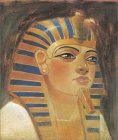
The following books are the top selections from Amazon.com, but Amazon carries twenty books of relevance to Hatshepsut. For a list of all twenty, click here.

More Info/Buy
$11.96
(latest price, may not be current)
by Joyce Tyldesley
Egypt's Queen--or, as she would prefer to be remembered, King--Hatchepsut ruled over an age of peace, prosperity, and remarkable architectural achievement (c. 1490 b.c.). Had she been born a man, her reign would almost certainly have been remembered for its stable government, successful trade missions, and the construction of one of the most beautiful structures in the world--the Deir el-Bahri temple at Luxor. After her death, however, her name and image were viciously attacked, her monuments destroyed or usurped, her place in history systematically obliterated. At last, in this dazzling work of archaeological and historical sleuthing, Joyce Tyldesley rescues this intriguing figure from more than two thousand years of oblivion and finally restores the female pharaoh to her rightful prominence as the first woman in recorded history to rule a nation.
"Tyldesley works closely from surviving texts and fragmentary monuments to recreate vividly an outstanding woman of the ancient past." -- Kirkus Reviews

More Info/Buy
$13.60
(latest price, may not be current)
Hatshepsut, His Majesty,
Herself
by Catherine M. Andronik, Joseph Daniel Fiedler (Illustrator)
MEET HATSHEPSUT, PHAROAH OF EGYPT Here is an engaging and informative picture-book biography, lushly illustrated by award-winning artist Joseph Daniel Fiedler, of Egypt's only successful female pharaoh. Hatshepsut gained Egypt's throne when all her male siblings -- including the half brother whom she married -- died. Originally named regent to her nephew, Tuthmosis III, Hatshepsut gradually assumed more and more power, and eventually had herself crowned pharaoh. Since no word existed for a female ruler, Hatshepsut used the male title. She also wore men's clothing and a beard, and referred to herself as "he" as well as "she." Hatshepsut's reign was a peaceful and prosperous one. She sent an expedition to explore Punt, an exotic land of riches, and built beautiful monuments, including a magnificent temple on which she had artists carve and paint scenes from her life and reign. Following her death, Tuthmosis III tried to erase evidence of Hatshepsut's reign to make it seem as though he had succeeded his father directly. Catherine M. Andronik explains how, despite this vandalism, archaeologists have been able to piece together the story of this unconventional pharaoh's remarkable and mysterious life.
"Fiedler's stately pictures emulate the feel of ancient Egyptian artwork and make this historical figure all the more real and intriguing." -- Publisher's Weekly

More Info/Buy
$15.89
(latest price, may not be current)
His Majesty, Queen Hatshepsut
by Dorothy Sharp Carter, Michele Chessare (Illustrator), Dorothy Michele
Carter
To be born Egyptian is immense fortune.Hatshepsut, a thirteen-year-old Egyptian princess, doesn't feet that she is entirely fortunate. After all, she is a girl. She grumbles about taking lessons with her brothers. Why should she study reading and writing, literature, history, and mathematics? As a princess, she will never need to be skilled at these things. But Hatshepsut little knows what life has in store for her. She will need to know all these things and more. By the time she is fourteen years old, she will be a wife, and shortly thereafter, a queen. The early death of her husband makes Hatshepsut Queen-Regent, ruling jointly with her husband's son -- a son who is only a child, and the child of a concubine at that. Hatshepsut thrives as Queen-Regent, creating opportunities to act for the good of her people and the glory of Egypt. Yet she chafes at sharing her reign with a child. Seizing the supreme opportunity, Hatshepsut names herself Pharaoh, setting aside the young heir to the throne. She rules as King of Upper and Lower Egypt for more than twenty years.
"I read this book last year to my 5th grade Waldorf School class during our study of ancient Egypt. The class loved it. They were engaged and since I read it I was able to answer their questions." -- A reader from Baltimore, MD

More Info/Buy
$12.00
(latest price, may not be current)
Child of the Morning
by Dorothy Sharp Carter, Michele Chessare (Illustrator), Dorothy Michele
Carter
Child of the Morning is Pauline Gedge's historical fiction account of the life of Pharoah (or Queen depending on your source) Hatshepsut. In this work, Pauline Gedge recreates the world of Pharoah Thothmoses I, specifically the court where his two children a son, Thothmoses II, and a daughter, Hatshepsut, grow up. As we watch these children grow, it becomes clear that Hatshepsut is suited to rule while her brother is not. There is, however, a problem. Egypt has never had a female Pharoah. Can she be accepted by the military? The People? The Priesthood? and the Nobility? Or would Egypt prefer a male Pharoah who is not fit to be called a god? How will Thothmoses I deal with the issue of succession and how can he assure that his wishes are carried out? Child of the Morning is a wonderful book of politics, social commentary and wisdom.
" [a] fine historical tale." -- Publisher's Weekly
"It's like reading Hatshepsut talking about herself. I think this book is great, I read it two years ago, and I really love it, I am an ancient Egypt lover, I am 17, and thanks to this book I realize how it was being a women in ancient Egypt, I think it's a great book, Pauline Gedge make us enter the Ancient times, and it make us see the life of a wonderful lady; I think Hatshepsut is a wonderfuul woman, and all thanks to this book." -- Laura Arellano from Puebla, Mexico